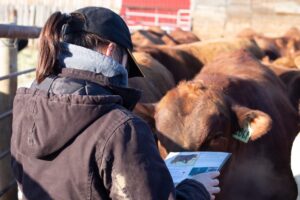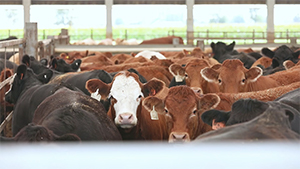
This Level 3 module has been designed to build upon the modules covered in Genetics Record-Keeping Level 1 and Level 2. These modules are designed to be used by a wide range of producers and management systems. The purpose of Level 3 is to dig deeper into analysis and application of collected farm data.
In Level 2, identifying your operation’s breeding goals and individual animal identification was discussed. To identify bulls with better calf performance, start by reflecting on what your goals are, and which traits will help you achieve your goals.
Access a comprehensive Beef Cattle Genetics Glossary.
Identifying Bulls that Support Your Goals
Once traits have been identified that support your goals, you can compare the performance of calves sired by each bull for these traits. For example, comparing the average weaning weights of live calves sired by all bulls can be used to identify the bull(s) siring calves with higher weaning weights. This provides valuable information when making culling and breeding decisions.
Bull selection is one of the most important decisions for cow-calf producers, with implications for short- and long-term profitability of the operation. The choice of bull can be immediately seen in the next calf crop. If the operation retains heifers and/or bulls, the genetics in the selected bull will be passed down to subsequent generations. Introducing new genetics is a permanent change to the herd, compared to the relatively temporary nature of many feeding management practices. As such, bull selection can be seen as a long-term investment into the operation and should be viewed as an opportunity to make significant genetic improvements.
After the initial investment of purchasing a herd sire, the bull will only provide a return on this investment if he is siring calves. Parentage testing using DNA sampling, particularly on multi-sire pastures, can indicate whether a bull is siring calves as expected. Identifying the progeny of each bull can also provide an opportunity to determine whether a particular bull is:
- Siring calves with traits that support your production goals
- Consistently producing calves with undesirable traits (e.g. poor conformation, calving ease, etc.)
- Not siring as many calves as expected.
The following webinar includes more details about DNA testing in commercial herds with multi sire pastures.
For more information about bull selection, review the Bull Selection series.
Calving Ease Data
Calving ease is a key trait that influences profitability. It is estimated the majority of calf death loss is a result of difficult delivery (dystocia). Dystocia can be caused by a large pre-natal calf, small pelvic area of the dam, lack of sufficient uterine contractions, insufficient dilation of the cervix, or mispositioned calf prior to birth2.
Dystocia results in higher labor costs, decreased calf survival, and delayed rebreeding for the cow, resulting in younger calves at weaning the following year. Issues with dystocia within the herd can be addressed by keeping calving ease records.
Calving ease can be scored using the scores listed in Table 1.
Cows that calve between regular checks can be assumed to have calved without assistance even if the calving was not observed. A score of 1 should be reported for these. All calvings should receive a score even if the calf is born dead. These scores may then be used when making culling decisions, particularly if dystocia has been an issue.
Similar to adjusted weaning weights, calving ease comparisons should be made according to contemporary or management group2. Calving ease EPDs are produced from calving difficulty scores and birth weight observations.
The Beef Improvement Federation (BIF) suggests that birth weights alone should not be used as selection criteria and to use calving ease information, if available, instead when making culling or breeding decisions.
Table 1: Beef Improvement Federation calving ease scoring guidelines
| Score | Description |
|---|---|
| 1 | No difficulty, no assistance required |
| 2 | Minor difficulty, some assistance |
| 3 | Major difficulty, usually mechanical assistance |
| 4 | Caesarean section or other surgery |
| 5 | Abnormal presentation |
Calf birth weight is an indicator trait for calving difficulty. If calving difficulty is a problem in the herd, and calving ease EPDs are not available, selection of breeding animals for lighter birth weight may be an effective strategy to improve direct calving ease. However, selecting for a single trait such as lighter birth weight or shorter gestation intervals may reduce calf viability and growth rate from birth to maturity3.
For seedstock breeders that intend to sell bulls or seedstock females, birth weights must be measured accurately prior to submitting to the breed association for EPD calculation. Accurate birth weights should be measured using a scale. Visual assessment or taping is not considered an accurate measurement.
Data to record:
- birth weight
- calving ease score
When to record it:
- at birth
Example:
During the morning calf check, three live calves were found. The record for each calf is given a calving ease score of 1 because the calves were all born unassisted.
At culling, your records indicate that most of the herd received a calving ease score of 2 or less. Cows that received a score of 3 or higher are moved into the cull pen.
Post Weaning Gain and Yearling Weight
In Level 1, the collection and use of weaning weight records was discussed. For operations that retain calf ownership or those that are raising replacement heifers, they may consider collecting post weaning gain and/or yearling weights.
Post Weaning Gain

Higher growth rates can mean fewer days on feed and lower input costs to reach market weight. Post weaning gain on animals with retained ownership may be linked to sire and dam performance, which can assist with making culling decisions. As with birth and weaning weights, post weaning gains should be taken using an accurate livestock scale.
Data to record:
- body weight
When to record it:
- when received from feedlot or after on-farm weigh-in
Example:
The average weaning weight for a group of feeder calves was 550 lbs. After the second weight collection, the group averaged 3 lbs of gain per day. Weights were also given for individual animals according to their CCIA tag number. Sorting the weight data from high to low revealed that all of lighter animals came from the same sire, suggesting the bull may need to be replaced.
Yearling Weight
For replacement heifers, yearling weight records can provide valuable information about the potential of the heifer as a breeding female. It has been suggested that heifers that have reached one year of age should be approximately 55-65% of their expected mature weight5. This guideline is to ensure that yearling heifers will reach sexual maturity prior to the breeding season. This also allows heifers to be bred prior to the mature cow herd and will give heifers enough time to recover from the first calving to rebreed for her second calf.
It should be noted that selecting replacement heifers to produce calves with higher yearling weights can result in larger cows. This needs to be taken into consideration to account for the environment these females will have to survive in since larger cows will need more feed.
Data to record:
- 365-day weight
When to record it:
- 160 days after weaning weight or when average group age is between 320 and 410 days.
Example:
A group of heifers has reached an average age of 360 days. Individual weights are recorded to the nearest pound. The average for the group of heifers is 800 lbs and the average weight of the mature cow herd is 1600 lbs.
800 lbs / 1600 lbs x 100% = 50% of mature cow weight
The group of heifers was divided into two groups, calves sired by Bull A or Bull B. The heifers from Bull A have an average weight of 900 lbs and Bull B’s heifers have an average of 750 pounds.
Bull A sired: 900 lbs / 1600 lbs x 100% = 56%
Bull B sired: 650 lbs / 1600 lbs x 100% = 47%
The breeding season is still 60 days away. If the heifers are gaining 2 lbs per day on average, that gives each group an opportunity to gain 120 lbs prior to breeding. This would bring each group to:
Bull A sired: 1020 lbs/1600 lbs x 100% = 64%
Bull B sired: 870 lbs/ 1600 lbs X 100% = 54%
Comparing the heifers by sire can identify the females with the greatest potential to pass growth traits onto her offspring and identify the bulls with better replacement heifer performance
- REFERENCES
Feedback
Acknowledgements
Thanks to:
- Canadian Beef Breeds Council (CBBC)
- Alberta Beef Producers (ABP)
- Saskatchewan Ministry of Agriculture
- Maritime Beef Test Station
- University of Guelph
for their time and expertise in review of the contents of this page.
This content was last reviewed December 2024.